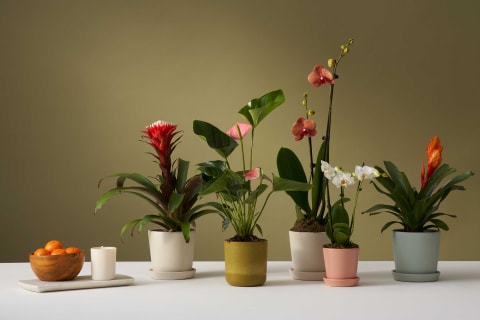
Graphic by mbg creative x Ivan Samkov / Pexels
November 29, 2022
Our editors have independently chosen the products listed on this page. If you purchase something mentioned in this article, we may
Advertisement
This ad is displayed using third party content and we do not control its accessibility features.
When you think indoor plants, images of green foliage probably come to mind, but it’s about time flowering plant varieties have a moment.
Interest in indoor plants has seen a major boom in the past few years (likely as a result of more time spent at home amid the COVID-19 pandemic), and it’s now starting to evolve in a colorful way. In 2023, we’re predicting a rise in flowering houseplants, as avid indoor gardeners look to brighten things up at home with pops of color.
Here’s the science behind why more flowers could actually be just what we’re missing—plus the flowering plants to watch out for this year.
Why bring flowers indoors?
Flowers are, without question, one of life’s simple pleasures that everyone can enjoy. Plenty of research supports the idea that flowers can support our mental well-being, with one 2021 study1 actually concluding yellow flowers can improve feelings of relaxation (even amid a pandemic).
Another 2015 study2 found that indoor plants in general can reduce psychological and physiological stress in young adults “through suppression of sympathetic nervous system activity and diastolic blood pressure, and promotion of comfortable, soothed, and natural feelings.”
And as Matthew Wichrowski, MSW, HTR, a horticultural therapist at NYU, tells mindbodygreen, we have a natural inclination toward flowers that stems from our time as hunters and gatherers—when the presence of flowers meant fruit or nuts would soon follow a bloom.
“We have an innate, biophilic attraction to flowers. We tend to respond to flowers with a true Duchenne smile […] When we give flowers to someone, we are saying deep down that we would like to feed and care for this person,” Wichrowski explains.
Advertisement
This ad is displayed using third party content and we do not control its accessibility features.
Flowering plants are on the rise.
If you could use a little more color in your space, you wouldn’t be alone. Lindsay Pangborn, Bloomscape’s gardening expert, predicts that soon, “We will definitely see plants with bold foliage that stray away from the typical green houseplants trending in consumer purchases.”
She notes that as the return to work becomes more solidified in the coming year, “We’ll be seeing consumers prioritizing their office spaces, whether in their work buildings or home workstations,” adding that plants double as décor and a way to improve productivity and creativity.
And as Erin Marino with The Sill tells mindbodygreen, the plant retailer is seeing consistent interest in their flowering varieties. The company launched a blooming collection of plants in 2020 as a response to the pandemic, in the hopes that it would lift spirits, and customers were super into it.
“The collection—mostly orchids—was meant to be a limited-time offering but resonated with our customers and community so much, it’s become a core part of our plant assortment,” Marino says, adding that flowering plants like Phalaenopsis orchids, Bromeliads, and Anthuriums consistently hold spots within their top 20 products.
Pangborn, too, has seen Bromeliads be a hit among flowering plant enthusiasts, thanks to their long-lasting blooms, as well as Red Anthuriums, which feature gorgeous scarlet-red flowers. And don’t forget that plants don’t need to actually have flowers to be colorful! Burgundy Rubber Trees, for example, have dramatic, dark red undertones, and Stromanthe Triostars have white and green leaves splashed with a bold hot pink underside, Pangborn tells mbg.
Additional houseplant trends to watch for.

Image by The Sill / The Sill
Advertisement
This ad is displayed using third party content and we do not control its accessibility features.
Along with an increased interest in colorful and/or flowering indoor plants, Pangborn says we can expect to see more demand for large and/or economical plants in 2023.
“As houseplants become an essential part of interior design, oversize, treelike plants that can add dimension and color to areas with high ceilings are great stand-alone décor pieces,” she notes.
And of course, plant enthusiasts will also be taking the economy into account and thinking about how to keep their indoor gardens thriving on a budget. “As we’re seeing the economy fluctuate and cost of living increase throughout the nation, we’ll be seeing a greater investment in adaptable plants that are suitable for both indoor and outdoor settings,” Pangborn explains.
To that end, people will want not only colorful or flowering plants but also plants known for resiliency that can “withstand dramatic temperature changes and various light levels,” according to Pangborn. These are the options that will be the most convenient choice for new or seasoned plant parents in the year ahead, she adds.
Takeaway of the trend.
Indoor plants aren’t going anywhere—but they are getting more colorful, and according to research and plant experts, that’s a good thing for our mental health and well-being. Whether you opt for a single orchid or a corner of Bromeliads, adding pops of color is one simple way to make your home a little happier in the coming year.
Advertisement
This ad is displayed using third party content and we do not control its accessibility features.

